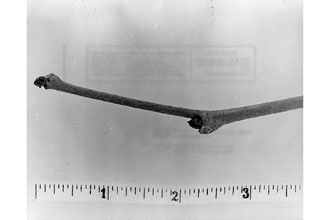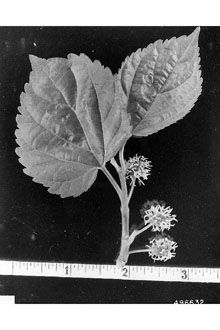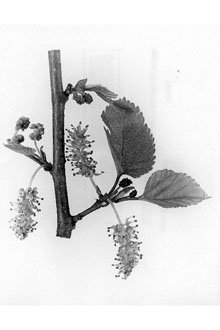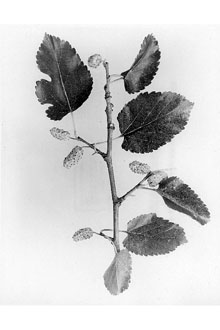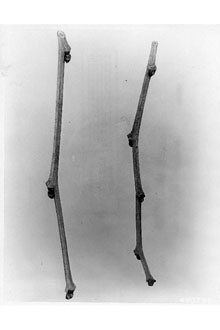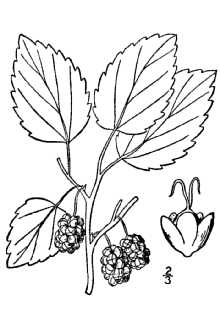Morus alba L. var. tatarica (L.) Ser.
Scientific Name: Morus alba L. var. tatarica (L.) Ser.
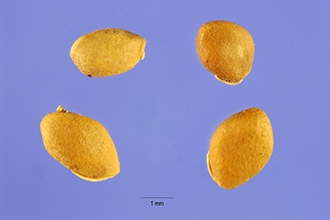
| General Information | |
|---|---|
| Usda Symbol | MOALT |
| Group | Dicot |
| Life Cycle | Perennial |
| Growth Habits | ShrubTree, |
| Native Locations | MOALT |
Plant Guide
Alternative Names
Chinese white mulberry, common mulberry, Russian mulberry, silkworm mulberry, chi sang, chin sang, moral blanco
Uses
Ethnobotanic: The fruits may be eaten cooked or raw and are made into jellies, jams, pies and is added to bread, cookies, or puddings. The fruit is also an ingredient in mulberry wine and is used as a raisin substitute. The inner bark was roasted and grounded into a meal and then used as a thickener in soups or mixed with cereals when making bread. The young shoots were used as a tea substitute Economic: White mulberry was introduced along the Atlantic seaboard during colonial times when an attempt was made to establish the silkworm industry in this country (Harrar & Harrar 1962). A fiber was obtained from the bark and used in weaving. A brown dye can be obtained from the trunk. The wood is valued for sporting goods due to its durability, flexibility, and elasticity. It is used mainly for tennis and badminton rackets, hockey sticks, furniture, agricultural implements, and house and boat building materials. The stem is fibrous and is used in Europe and China for making paper. Medicinal: The leaves are taken internally in the treatment of sore throats, colds, eye infections, and nose bleeds. The stems are used in the treatment of spasms, rheumatic pains, and high blood pressure. The fruit is used in the treatment of urinary incontinence, dizziness, diabetes, pre-maturing gray hair, and constipation in the elderly. Wildlife: White mulberry leaves are eaten as a vegetable and are useful as a cattle fodder. Wild birds, hogs, and poultry eat the mulberry fruit. Department of Botany University of Wisconsin, Madison Agroforestry: Morus alba is used in tree strips for windbreaks. They are planted and managed to protect livestock, enhance production, and control soil erosion. Windbreaks can help communities with harsh winter conditions better handle the impact of winter storms and reduce home heating costs during the winter months.
Status
Introduced into the U.S. and it is considered invasive by several sources. Please consult the Plants Web site and your State Department of Natural Resources for this plant’s current status, such as, state noxious status and wetland indicator values.
Weediness
This plant may become weedy or invasive in some regions or habitats and may displace desirable vegetation if not properly managed. Please consult with your local NRCS Field Office, Cooperative Extension Service office, state natural resource, or state agriculture department regarding its status and use. Weed information is also available from the PLANTS Web site at plants.usda.gov. Please consult the Related Web Sites on the Plant Profile for this species for further information.
Description
General: Mulberry family (Moreaceae), White mulberry is an introduced, small to medium sized shrub or tree, Use soil moisture sensors to measure the soil moisture of Morus alba L. var. tatarica (L.) Ser.., The leaves are alternate, simple, serrate or dentate, ovate to broad ovate, and two to seven inches long (Dirr 1990), The flowers are small, greenish, crowded in clusters, and hanging in catkins, The fruit is blackberry like, typically white but sometimes pinkish violet, insipid and so plentiful it litters lawns and pavements (Taylor 1965), The bark is light brown to gray and smooth, becoming divided into narrow scaly ridges, Distribution: Morus alba is a Chinese tree, cultivated throughout the world wherever silkworms are raised, It is occasionally cultivated in Japan, Europe, North America, and Africa, In Michigan, white mulberry is frequent in urban environments in the southern half of the Lower Peninsula, occasionally in the northern half of the Lower Peninsula and the Upper Peninsula (Barnes & Wagner 1981), This species is naturalized in the urban environment and rare in disturbed forest communities (Ibid,), For current distribution, please consult the Plant profile page for this species on the PLANTS Web site,
Adaptation
White mulberry grows well on a wide variety of soils. It prefers a warm, moist, well-drained loamy soil in a sunny position. It withstands drought once well established. Morus alba is quite salt tolerant. This species is also fairly wind-resistant.
Establishment
Propagation from Seed: Sow the seeds as soon as they are ripe in a cold frame. Germination of fresh seed may vary because some seed will contain dormant embryos and impermeable seed coats (Dirr & Heuser 1987). Germination is improved by cold stratification at 33 to 41ºF for one to three months (Ibid.). After germination, the seeds require half shade for a few weeks. Propagation from Cuttings: Cutting are taken from bushes at pruning time. The branches are cut twenty-two to thirty centimeters long with three buds and planted immediately. June and July are optimum months for rooting (Dirr & Heuser). The cuttings are buried in soil about six to nine centimeters deep and watered frequently. After about a month when the buds have shoots, they are taken out and planted. Mid July cuttings with bases are dipped in 8000 ppm IBA-talc and sand, that roots in three weeks with heavy root systems (Ibid).
Management
Mulberries have brittle roots and need to be handled with care when being planted. Pruning should be done in the winter when the plant is fully dormant. Only badly placed branches or dead wood should be removed during pruning. Mulberries are bleeders and should not be cut when the sap is flowing. Different mulberry trees vary in fruit production. Sericulture is the most important commercial use for white mulberry. Young, fully developed leaves are best for feeding silkworm larvae. White mulberry can become weed trees as fruits are distributed by birds and other wildlife (Dirr 1997).
Control
Please contact your local agricultural extension specialist or county weed specialist to learn what works best in your area and how to use it safely. Always read label and safety instructions for each control method. Trade names and control measures appear in this document only to provide specific information. USDA NRCS does not guarantee or warranty the products and control methods named, and other products may be equally effective. Cultivars, Improved and Selected Materials (and area of origin) ‘Charparral’, ‘Pendula’, ‘Teas’, ‘Bellaire’, and ‘Lingan’ are some of the cultivars of Morus alba. ‘Charparral’ is fruitless, with a weeping form, reaching a height of twelve feet. ‘Pendula’ has a slender weeping form, reaching a height and spread of twenty feet. ‘Teas’ is grown for its edible fruit. ‘Bellaire’ has a distinctive form and multiple trunk (Dirr 1990), ‘Lingan’ is a type with leathery, lustrous foliage. It is fruitless, fast growing, and drought resistant (Ibid.). Consult your local nurseries to choose the right cultivar for your specific landscape.
References
Brown, C.L. & L.K. Kirkman 1990. Trees of Georgia and adjacent states. Timber Press, Portalnd, Oregon. Britton, N.L. 1908. North American trees. Henry Holt & Company, New York. Bruggen, T.V. 1976. The vascular plants of South Dakota. The Iowa State University Press, Ames, Iowa. Dirr, M.A. 1990. Manual of woody landscape plants: their identification, ornamental characteristics, culture, propagation, and uses. 4th ed. Stipes Publishing Co., Champaigne, Illinois. Dirr, M.A. 1997 Dirr’s hardy trees and shrubs: an illustrated encyclopedia. Timber Press, Portland, Oregon. Dirr, M.A. & C.W. Heuser, Jr. 1987. The reference manual of woody plant propagation: from seed to tissue culture. Varsity Press, Athens, Georgia. Epple, A.O. 1995. A field guide to the plants of Arizona. Falcon Press, Helena, Montana. Facciola, S. 1990. Cornucopia-a source book of edible plants. Kampong Publications. Farrar, J.L. 1995. Trees of the northern United States and Canada. Iowa State University Press, Ames, Iowa. Great Plains Flora Association 1986. Flora of the great plains. University press of Kansas, Lawerence, Kansas. Harrar, E.S. & J.G. Harrar 1962. Guide to southern trees. 2nd ed. Dover Publications, Inc., New York, New York. Hunter, C.J. 1989. Trees, shrubs, and vines of Arkansas. The Ozark Society Foundation, Little Rock, Arkansas. McMinn, H.E. & E. Maino 1963. An illustrated manual of Pacific Coast trees. University of California Press, Berkeley, California. Radford, A.E., H.E. Ahles, & C.R. Bell 1968. Manual of the vascular flora of the Carolinas. The University of North Carolina Press, Chapel Hill, North Carolina. Sargent, C.S. 1961. Manual of the trees of North America. Vol. 1. Dover Publications, Inc., New York, New York. Strausbaugh, P.D. & E.L. Core 1971. Flora of West Virginia. 2nd ed. Seneca Books, Inc., Morgantown, West Virginia. Taylor, N. 1965. The guide to garden shrubs and trees. Houghton Mifflin Company, Boston, Massachusetts. University of Wisconsin 2002. Morus alba. Department of Botany, Madison, Wisconsin. Accessed: 11jan02. <http://www.wisc.edu/botit/img/bot/130/Plant%20Morphology/130%20Required%20Terms/Leaf%20Structure/Lobed/>
Plant Traits
Growth Requirements
| Temperature, Minimum (°F) | -18 |
|---|---|
| Adapted to Coarse Textured Soils | Yes |
| Adapted to Fine Textured Soils | Yes |
| Adapted to Medium Textured Soils | Yes |
| Anaerobic Tolerance | None |
| CaCO3 Tolerance | None |
| Cold Stratification Required | Yes |
| Drought Tolerance | Medium |
| Fertility Requirement | Low |
| Fire Tolerance | Low |
| Frost Free Days, Minimum | 130 |
| Hedge Tolerance | Low |
| Moisture Use | Low |
| pH, Maximum | 7.0 |
| pH, Minimum | 5.0 |
| Planting Density per Acre, Maxim | 600 |
| Planting Density per Acre, Minim | 170 |
| Precipitation, Maximum | 60 |
| Precipitation, Minimum | 30 |
| Root Depth, Minimum (inches) | 24 |
| Salinity Tolerance | Medium |
| Shade Tolerance | Intermediate |
Morphology/Physiology
| Bloat | None |
|---|---|
| Toxicity | None |
| Resprout Ability | Yes |
| Shape and Orientation | Rounded |
| Active Growth Period | Spring and Summer |
| C:N Ratio | High |
| Coppice Potential | Yes |
| Fall Conspicuous | No |
| Fire Resistant | No |
| Flower Color | Green |
| Flower Conspicuous | No |
| Foliage Color | Green |
| Foliage Porosity Summer | Moderate |
| Foliage Porosity Winter | Porous |
| Foliage Texture | Medium |
| Fruit/Seed Conspicuous | Yes |
| Nitrogen Fixation | None |
| Low Growing Grass | No |
| Lifespan | Moderate |
| Leaf Retention | No |
| Known Allelopath | No |
| Height, Mature (feet) | 50.0 |
| Height at 20 Years, Maximum (fee | 30 |
| Growth Rate | Moderate |
| Growth Form | Single Stem |
| Fruit/Seed Color | Purple |
Reproduction
| Vegetative Spread Rate | None |
|---|---|
| Small Grain | No |
| Seedling Vigor | High |
| Seed Spread Rate | Moderate |
| Fruit/Seed Period End | Summer |
| Seed per Pound | 235000 |
| Propagated by Tubers | No |
| Propagated by Sprigs | No |
| Propagated by Sod | No |
| Propagated by Seed | Yes |
| Propagated by Corm | No |
| Propagated by Container | Yes |
| Propagated by Bulb | No |
| Propagated by Bare Root | Yes |
| Fruit/Seed Persistence | No |
| Fruit/Seed Period Begin | Spring |
| Fruit/Seed Abundance | High |
| Commercial Availability | Routinely Available |
| Bloom Period | Early Spring |
| Propagated by Cuttings | Yes |
Suitability/Use
| Veneer Product | No |
|---|---|
| Pulpwood Product | No |
| Protein Potential | Low |
| Post Product | No |
| Palatable Human | No |
| Palatable Browse Animal | Low |
| Nursery Stock Product | Yes |
| Naval Store Product | No |
| Lumber Product | No |
| Fuelwood Product | Low |
| Fodder Product | No |
| Christmas Tree Product | No |
| Berry/Nut/Seed Product | Yes |

